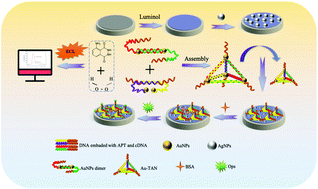A novel label-free electrochemiluminescence aptasensor using a tetrahedral DNA nanostructure as a scaffold for ultrasensitive detection of organophosphorus pesticides in a luminol–H2O2 system
Abstract
In this work, a new type of Au-tetrahedral DNA nanostructure (Au-TDN) was originally proposed and successfully applied in an electrochemiluminescence aptasensor to detect organophosphorus pesticides (Ops). The aptamers modified with –SH could be covalently bonded with gold nanoparticles (AuNPs) to form a tetrahedron structure, and there were independent probes at each vertex of the tetrahedron, which could increase the probability of specific binding with Ops. The originally designed structure could not only maintain a stable tetrahedral configuration, but also combined with the target to improve the sensitivity of the sensor. Meanwhile, silver nanoparticles (AgNPs) could catalyze the chemical reaction between luminol and H2O2 to generate a variety of intermediates called reactive oxygen species (ROS) for signal enhancement. Factors that had important influences on the aptasensor, such as the concentration of Au-TDN, the incubation time, and the pH value of the buffer, were optimized in this trial. According to the final results, the limit of detection (LOD) of 3 pg mL−1 (S/N = 3) for methyl parathion, the LOD of 0.3 pg mL−1 (S/N = 3) for parathion and the LOD of 0.03 pg mL−1 (S/N = 3) for phoxim were obtained, respectively. Moreover, the novel tetrahedral structure could be replaced by different types of aptamers to expand its application range and lay a foundation for the development of portable rapid detection devices for pesticide residues.



 Please wait while we load your content...
Please wait while we load your content...